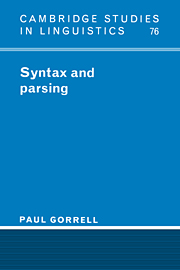5 - Modularity and Structural Determinism
Published online by Cambridge University Press: 30 March 2010
Summary
Modularity is certainly a term whose time has come … What is considerably less clear is whether the term retains a constant meaning when it passes from one author to another.
John C. MarshallIn this chapter I will be taking up the specific issue of the role of semantic and pragmatic factors in syntactic processing. I will not, however, be developing a theory of semantic and discourse processing. Rather, the focus here will be on incremental, deterministic, structure building and how this process is affected by nonsyntactic information. In order to draw out the main issues, I will contrast two views: (i) the modular theory (MT) of Rayner et al. (1983) and Clifton and Ferreira (1989), and (ii) the interactive theory (IT) of Crain and Steedman (1985) and Steedman and Altmann (1989). One reason to contrast these particular proposals is that they have each focused on the use of discourse information in the processing of a particular ambiguity – the reduced-relative ambiguity which has been a focus of research since Bever (1970). Also, this ambiguity has been extensively studied with sensitive experimental techniques for the last few years. Thus, there is perhaps more data available for assessing the time course of information availability and use in ambiguous reduced-relative constructions than for any other type of processing phenomenon. Given this, it will serve as a useful probe into how Structural Determinism might be embedded in a more general language comprehension mechanism.
- Type
- Chapter
- Information
- Syntax and Parsing , pp. 149 - 162Publisher: Cambridge University PressPrint publication year: 1995



